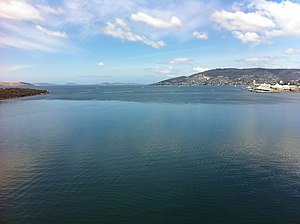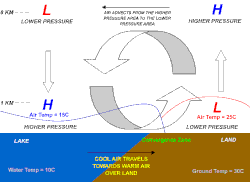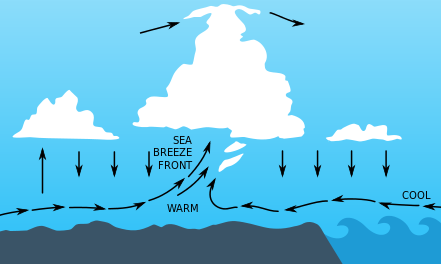226:. If the flow aloft is aligned with the direction of the sea breeze, places experiencing the sea breeze frontal passage will have benign, or fair, weather for the remainder of the day. At the front warm air continues to flow upward and cold air continually moves in to replace it and so the front moves progressively inland. Its speed depends on whether it is assisted or hampered by the prevailing wind, and the strength of the thermal contrast between land and sea. At night, the sea breeze usually changes to a land breeze, due to a reversal of the same mechanisms.
318:
33:
45:
187:
394:
breeze can be a good predictor for the activity on land the following day, as long as there are no expected changes to the weather pattern over the following 12–24 hours. This is mainly because the strength of the land breeze is weaker than the sea breeze. The land breeze will die once the land warms up again the next morning.
241:
160:
ground. The strength of the sea breeze is directly proportional to the temperature difference between the land and the sea. If a strong offshore wind is present (that is, a wind greater than 8 knots (15 km/h)) and opposing the direction of a possible sea breeze, the sea breeze is not likely to develop.
417:
do not rely on these winds, a nearshore wind farm is a type of offshore wind farm located on shallow coastal waters to take advantage of both sea and land breezes. For practical reasons, other offshore wind farms are situated further out to sea and rely on prevailing winds rather than sea breezes.
393:
Land breeze, which consists of cool air coming from the land, pushes the warmer air upwards over the sea. If there is sufficient moisture and instability available, the land breeze can cause showers, or even thunderstorms, over the water. Overnight thunderstorm development offshore due to the land
295:
On calm summer afternoons with little prevailing wind, sea breezes from both coasts may collide in the middle, creating especially severe storms down the center of the state. These thunderstorms can drift towards either the west or east coast depending on the relative strengths of the sea breezes,
159:
states that the hydrostatic pressure depends on the temperature. Thus, the hydrostatic pressure over the land decreases less at higher altitude. As the air above the coast has a relatively higher pressure, it starts moving towards the sea at high altitude. This creates an inverse airflow near the
384:
winds move across the New South Wales coast, and frictional contrasts over the mainland and the ocean that disconnect the flow. Temperature changes can be dramatic, with falls of 10 to 15 °C (18 to 27 °F) often occurring in a few minutes.
168:
At night, the land cools off faster than the ocean due to differences in their heat capacity, which forces the dying of the daytime sea breeze as the temperature of the land approaches that of the ocean. If the land becomes cooler than the adjacent
276:, respectively. During the wet season, which typically lasts from June through September/October, any direction that the winds are blowing would always be off the water, thus making Florida the place most often struck by
173:, the air pressure over the water will be lower than that of the land, setting up a land breeze blowing from the land to the sea, as long as the environmental surface wind pattern is not strong enough to oppose it.
360:
and a dramatic temperature drop, thus ultimately replacing and relieving the prior hot conditions. Marking the boundary between hot and cool air masses, the southerly buster is sometimes represented by a
130:
The land breeze at nighttime is usually shallower than the sea breeze in daytime. Unlike the daytime sea breeze, which is driven by convection, the nighttime land breeze is driven by convergence.
123:. On the other hand, dry land also cools faster than water without solar radiation, so the wind instead flows from the land towards the sea when the sea breeze dissipates after
151:, so the surface of the sea warms up more slowly than the surface of the land. As the temperature of the surface of the land rises, the land heats the air above it by
296:
and sometimes survive to move out over the water at night, creating spectacular cloud-to-cloud lightning shows for hours after sunset. Due to its large size
593:
300:
may also contribute to this activity by creating its own lake breeze which collides with the east and west coast sea breezes.
525:
344:
causes an abrupt, squally southerly wind change, with gusts in excess of 40 knots (74 km/h), in coastal cities such as
489:
736:
Reid, H.J. 2000, "Regeneration of the
Southerly Buster of Southeast Australia". Weather and Forecasting Vol.15, pp432-446
561:
712:
512:
661:
636:
619:
453:
92:
may refer to any wind over open water. Sea breezes and land breezes are both important factors in coastal regions'
190:
Schematic cross section through a sea-breeze front. If the air inland is moist, cumulus often marks the front.
745:
THE DYNAMICS OF THE SOUTHERLY BUSTER P.G. Baines CSIRO Division of
Atmospheric physics, Aspendale, June 1980
773:
24:
20:
410:
303:
In Cuba similar sea breeze collisions with the northern and southern coasts sometimes lead to storms.
206:. The cold air from the sea meets the warmer air from the land and creates a boundary like a shallow
376:) that aligns the coast, as the cool air becomes trapped against the ranges. The mountains create a
588:
556:
431:
724:
631:
Henry, James (1998). The
Climate and Weather of Florida. Sarasota, Florida: Pineapple Press (FL).
252:. The northern sea breeze meets the southern sea breeze, creating a sharp convergence line in the
485:
170:
292:
especially during times when the upper atmosphere is cooler such as during the spring or fall.
280:
in the United States, and one of the most on Earth. These storms can also produce significant
377:
289:
758:
444:
373:
349:
156:
700:
8:
583:
439:, a sea breeze, though usually a storm, which is experienced in the southeast coast of
414:
235:
405:
are often situated near a coast to take advantage of the normal daily fluctuations of
356:, as it approaches from the southeast, mainly on a hot day, bringing in cool, usually
657:
632:
615:
521:
107:
of water and dry land. As such, Sea breezes and land breezes are more localised than
614:
Winsberg, Morton (2003). Florida
Weather. Gainesville: University Press of Florida.
678:
436:
427:
337:
312:
203:
108:
93:
440:
333:
297:
112:
477:
673:
357:
326:
273:
269:
551:
778:
767:
703:. The Australian Government Bureau of Meteorology. Accessed 21 February 2012.
253:
211:
199:
144:
104:
85:
65:
240:
223:
100:
448:
362:
317:
406:
369:
260:
Thunderstorms caused by powerful sea breeze fronts frequently occur in
207:
152:
32:
584:"Emergency Management - Lightning - How Bad Is Lightning In Florida?"
514:
Practical
Meteorology: An Algebra-based Survey of Atmospheric Science
402:
353:
277:
265:
219:
148:
81:
69:
285:
261:
249:
120:
44:
345:
124:
37:
682:. National Library of Australia. December 23, 1901. p. 2
322:
215:
116:
186:
381:
281:
245:
61:
36:
Sea breeze moving across the water (towards the viewer) in
482:
Cooperative
Institute for Meteorological Satellite Studies
725:
Shallow Cold Fronts - Cloud
Structure In Satellite Images
99:
Sea breeze and land breeze develop due to differences in
111:. Since land heats up much faster than water under
430:, the local name for the sea breeze in and around
765:
409:resulting from sea or land breezes. While many
520:. Univ. of British Columbia. pp. 654–656.
368:It is caused by the interaction of a shallow
115:, a sea breeze is a common occurrence along
471:
469:
654:A Dictionary of Australian Colloquialisms
229:
202:created by a sea breeze, also known as a
475:
316:
239:
185:
43:
31:
596:from the original on September 28, 2019
466:
48:Lake - Sea breeze and atmospheric depth
766:
706:
564:from the original on February 15, 2020
492:from the original on February 13, 2020
332:In the southeast Australian states of
325:during an afternoon sea breeze in the
306:
546:
544:
504:
268:bounded on the east and west by the
210:. When powerful this front creates
340:, an intense sea breeze called the
222:, the front can sometimes trigger
13:
541:
372:with the blocking mountain range (
14:
790:
752:
510:
454:Mountain breeze and valley breeze
652:, quoted in 1978, G. A. Wilkes,
388:
739:
730:
718:
181:
694:
666:
642:
625:
608:
576:
397:
163:
80:is any wind that blows from a
1:
459:
365:perpendicular to the coast.
138:
16:Wind blowing from sea to land
348:in New South Wales south to
7:
701:Southerly Busters Explained
421:
248:is very similar to that in
25:Bay breeze (disambiguation)
21:Sea breeze (disambiguation)
10:
795:
310:
244:Sea breeze convergence in
233:
214:clouds, and if the air is
176:
18:
103:created by the differing
589:Florida State University
557:National Weather Service
476:Ackerman, Steve (1995).
432:Perth, Western Australia
133:
64:that blows from a large
650:Recollections of Sydney
486:University of Wisconsin
171:sea surface temperature
84:toward or onto a large
478:"Sea and Land Breezes"
329:
284:due to the tremendous
257:
230:Sea breezes in Florida
191:
143:The sea has a greater
49:
41:
320:
243:
189:
47:
40:, Tasmania, Australia
35:
759:Sea and Land Breezes
443:, southern coast of
374:Great Dividing Range
350:Mallacoota, Victoria
157:hypsometric equation
19:For other uses, see
415:offshore wind farms
307:Southeast Australia
774:Marine meteorology
674:"SOUTHERLY BUSTER"
648:1850, B. C. Peck,
411:onshore wind farms
378:channelling effect
330:
258:
236:Climate of Florida
192:
50:
42:
527:978-0-88865-283-6
380:as the southerly
288:it causes in the
72:. By contrast, a
68:toward or onto a
786:
746:
743:
737:
734:
728:
722:
716:
713:Southerly buster
710:
704:
698:
692:
691:
689:
687:
679:Wellington Times
670:
664:
646:
640:
629:
623:
612:
606:
605:
603:
601:
580:
574:
573:
571:
569:
552:"The Sea Breeze"
548:
539:
538:
536:
534:
519:
508:
502:
501:
499:
497:
473:
437:Southerly buster
428:Fremantle Doctor
342:southerly buster
313:Southerly buster
204:convergence zone
196:sea-breeze front
109:prevailing winds
94:prevailing winds
794:
793:
789:
788:
787:
785:
784:
783:
764:
763:
755:
750:
749:
744:
740:
735:
731:
723:
719:
715:Marine Glossary
711:
707:
699:
695:
685:
683:
672:
671:
667:
647:
643:
630:
626:
613:
609:
599:
597:
582:
581:
577:
567:
565:
550:
549:
542:
532:
530:
528:
517:
511:Stull, Roland.
509:
505:
495:
493:
474:
467:
462:
441:New South Wales
424:
400:
391:
334:New South Wales
315:
309:
298:Lake Okeechobee
238:
232:
184:
179:
166:
141:
136:
113:solar radiation
105:heat capacities
78:offshore breeze
28:
17:
12:
11:
5:
792:
782:
781:
776:
762:
761:
754:
753:External links
751:
748:
747:
738:
729:
717:
705:
693:
665:
641:
624:
607:
575:
540:
526:
503:
464:
463:
461:
458:
457:
456:
451:
434:
423:
420:
399:
396:
390:
387:
358:severe weather
327:Sydney Harbour
311:Main article:
308:
305:
274:Gulf of Mexico
270:Atlantic Ocean
231:
228:
183:
180:
178:
175:
165:
162:
140:
137:
135:
132:
58:onshore breeze
15:
9:
6:
4:
3:
2:
791:
780:
777:
775:
772:
771:
769:
760:
757:
756:
742:
733:
726:
721:
714:
709:
702:
697:
681:
680:
675:
669:
663:
662:0-424-00034-2
659:
655:
651:
645:
638:
637:1-56164-036-0
634:
628:
621:
620:0-8130-2684-9
617:
611:
595:
591:
590:
585:
579:
563:
559:
558:
553:
547:
545:
529:
523:
516:
515:
507:
491:
487:
483:
479:
472:
470:
465:
455:
452:
450:
446:
442:
438:
435:
433:
429:
426:
425:
419:
416:
412:
408:
404:
395:
386:
383:
379:
375:
371:
366:
364:
363:roll-up cloud
359:
355:
351:
347:
343:
339:
335:
328:
324:
319:
314:
304:
301:
299:
293:
291:
287:
283:
279:
275:
271:
267:
263:
255:
251:
247:
242:
237:
227:
225:
224:thunderstorms
221:
217:
213:
209:
205:
201:
200:weather front
197:
188:
174:
172:
161:
158:
154:
150:
146:
145:heat capacity
131:
128:
126:
122:
118:
114:
110:
106:
102:
97:
95:
91:
90:offshore wind
87:
86:body of water
83:
79:
75:
71:
67:
66:body of water
63:
59:
55:
46:
39:
34:
30:
26:
22:
741:
732:
727:by EUMeTrain
720:
708:
696:
684:. Retrieved
677:
668:
653:
649:
644:
627:
610:
598:. Retrieved
587:
578:
566:. Retrieved
555:
531:. Retrieved
513:
506:
494:. Retrieved
481:
401:
392:
367:
341:
331:
302:
294:
259:
195:
193:
167:
142:
129:
101:air pressure
98:
89:
77:
73:
57:
53:
51:
29:
496:October 12,
449:New Zealand
398:Utilisation
389:Land breeze
164:Land breeze
88:. The term
74:land breeze
768:Categories
460:References
407:wind speed
403:Wind farms
370:cold front
321:A sailing
290:atmosphere
234:See also:
208:cold front
182:Sea breeze
153:convection
139:Sea breeze
54:sea breeze
686:March 27,
354:Melbourne
278:lightning
266:peninsula
594:Archived
562:Archived
533:July 31,
490:Archived
445:Victoria
422:See also
338:Victoria
220:unstable
82:landmass
70:landmass
600:June 2,
568:June 2,
286:updraft
262:Florida
254:cumulus
250:Florida
212:cumulus
177:Effects
121:sunrise
60:is any
660:
635:
618:
524:
346:Sydney
256:field.
155:. The
125:sunset
119:after
117:coasts
38:Hobart
518:(PDF)
323:skiff
216:humid
198:is a
147:than
134:Cause
779:Wind
688:2015
658:ISBN
633:ISBN
616:ISBN
602:2020
570:2020
535:2023
522:ISBN
498:2023
447:and
413:and
382:gale
352:and
336:and
282:hail
272:and
264:, a
246:Cuba
218:and
149:land
62:wind
23:and
76:or
56:or
770::
676:.
656:,
592:.
586:.
560:.
554:.
543:^
488:.
484:.
480:.
468:^
194:A
127:.
96:.
52:A
690:.
639:.
622:.
604:.
572:.
537:.
500:.
27:.
Text is available under the Creative Commons Attribution-ShareAlike License. Additional terms may apply.


